Introduction
Digital
Media Training has released Inside Motion 2. This new training
DVD-ROM is an extension of the Motion 1 Training DVD, which I
have reviewed already here.
For new customers, the Motion 2 trainer includes the prior Motion
1 training in the package. So Motion 1 and 2 customers should
simply purchase the Motion 2 training, which will give you both
trainers and will allow you to upgrade your software, without
having to upgrade your training.
Inside
Motion 1 is hosted by Megan Cunningham. However, this
new updated DVD-ROM is hosted by Jim Kanter, who has impressive credentials and an obvious talent for teaching. His style not only expresses the basics common in any feature-by-feature overview, but in addition, he has genuine creative talent and uses it effectively in these lessons.
Magnet
Media as always supplies the user with both video-based lessons
and training materials, giving you an instructor-led training
course with both visual direction and hands-on experience. Just
as with Inside Motion 1, you learn by watching and by doing.
Introduction and Overview
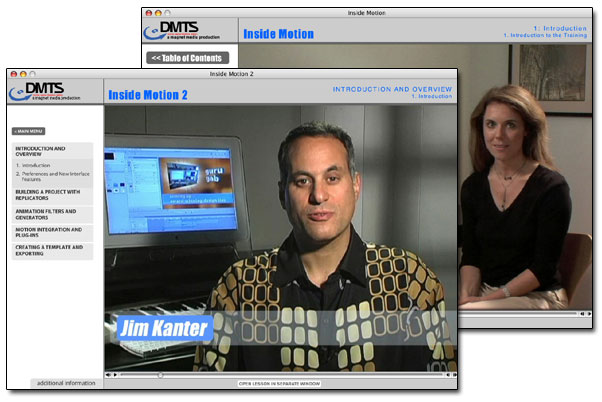
Because
Inside Motion 1 has already been reviewed, I will focus solely
on the updated DVD-ROM in this two-disc set. For a comprehensive
review of the first DVD-ROM included in this two-disc set, please
read Inside Motion. For new users of Motion who are just getting
started with Motion, it is suggested you start with Inside Motion
1, included in this package. Once you have completed that training,
begin the training provided in the second DVD-ROM.
Disc
two offers four main sections, which focus on building a project
with Motion's Replicators, working with animation filters and
generators, detailed examples of Motion integration and the use
of plug-ins, and finishes with creating templates and exporting.
Of
specific interest to many is working with Motion and After Effects
combined. There are new round-trip features that allow Motion
users to easily drop Motion projects into After Effects as After
Effects Compositions. This is a huge welcomed feature in that
it offers round-tripping. If you are an After Effects user as
I am, you may want to skip right to Motion Integration and Plug-ins
to see this for yourself before watching the DVD-ROM in its logical
order.
Building a Project
with Replicators
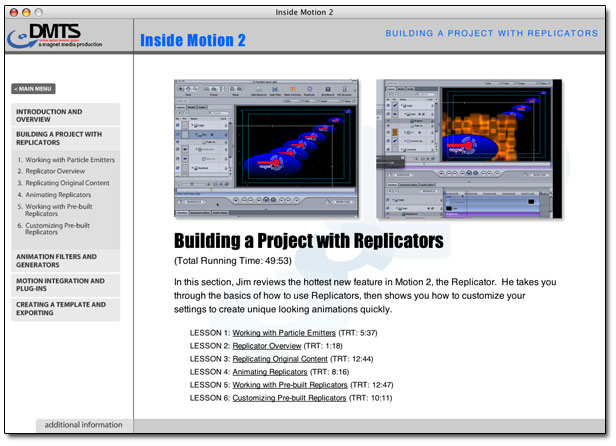
Immediately
as you begin watching the first section, you will see that Mr.
Kanter has some pretty insightful methods of adjusting your layers
to better organize and make use of your screen. Within the first
two minutes, I paused and wrote myself a note to that effect.
I'm always happy to gain a new tip when it concerns screen space,
and organizing my layers, especially because Motion produces
deep layers as it creates effects that make use of reference
objects and emitters.
In
addition, new users will learn to see the very assets that affect
playback speed: how to get rid of the items you don't need, and
to improve performance. As you watch these seemingly simple aspects
of working with Motion, you begin to realize just how flexible
it is, and how easily you can modify the pre-packaged particles
to suit your own needs. In fact, we see this again when working
between Motion and After Effects later, and it's really one of
the hallmarks of Motion.
Particles
of course are one of the features everyone raves about with Motion,
and once you realize how powerful they are, you're ready to dive
into a new feature of Motion 2 called Replicators. The replicator
is a very impressive feature of Motion 2, and the instruction
here really shows the potential.
Animation Filters and
Generators
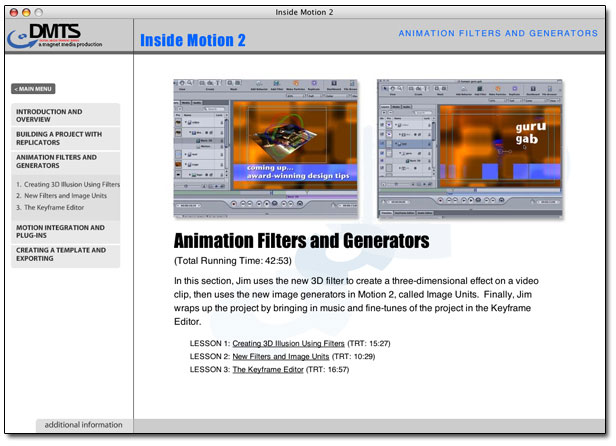
This
section of course focuses on animating objects. You'll learn
about the new control points you can add to a motion-path. In
addition the 3D filter is quite impressive, giving Motion a simulated
3D space interactivity. All of this is key-frame capable, and
the instruction again shows the potential quite well. The 3D
filter also allows you to set a back to the back of, say, a video
that has this filter applied. As you tumble a video in 3D space,
the back of the video could be a backdrop of your choice, rather
than the video itself in reverse. This is a nice touch, and learning
how to do this will give your 3D space effects that much more
of a professional look.
There
are new features here, such as extrude, that when combined with
the 3D space filter can really jazz up the presentation of fonts
without having to leave Motion for some other application, such
as Boris FX. Animating the movement of such titles in the style
of LiveType is also possible, sliding in each character of a
word that has extrude and 3D space applied. The total effect
is quite nice.
Motion Integration
and Plug-ins
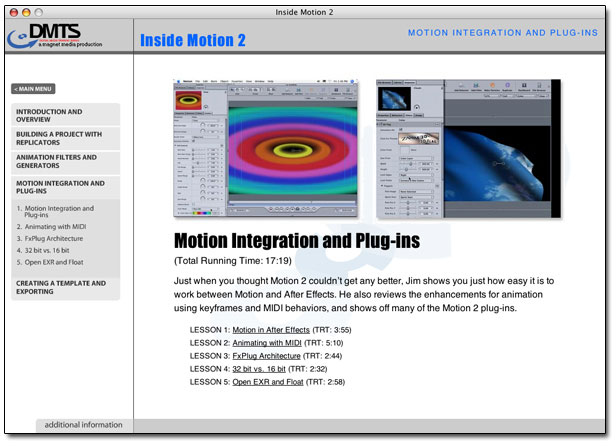
Motion
now offers round-tipping with Adobe After Effects. This is similar
to how you work between integrated applications such as Motion
and Final Cut Pro, and Motion and DVD Studio Pro. Now Motion
goes beyond Apple and integrates with After Effects. As with
Final Cut Pro and DVD Studio Pro, you can now take advantage
of the Edit Original option inside After Effects to further change
Motion compositions already imported into After Effects.
There
is an interesting lesson on adding key-frames automatically using
the MIDI option in the behaviors property.
Another
new benefit in the area of plug-ins is Apple's new FX-Plug. This
architecture gives third-party plug-in creators the ability to
take advantage of Motion's real-time architecture. You can gain
a little preview of what is to come from companies such as Zaxwerks.
There
is a great new feature overview of the Open EXR and 16 / 32 Float
Color Space. This is only available to those users using fast
processors and OS X 10.4. If you're going to start working with
HD, or even film, you'll be quite interested to see this.
Creating a Template
and Exporting
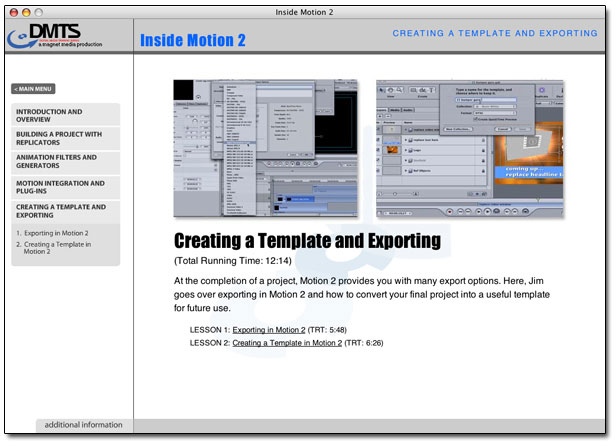
To
wrap up this excellent lesson, you learn to export, and create
a template for future exports. There are a few options here everyone
ought to be aware of, especially those who use alpha channels,
or wish to use Apple's newer codecs.
Conclusion
I
can't see this as anything other than the great value it is.
The lessons and their examples are much better than I had initially
expected. I've outlined here in this review many of the sections
I think are of particular note so that you have a good idea about
what will be covered, and what it will mean to you as a Motion
user. There are enough new features in this release of Motion
that I encourage you to explore it much more deeply than you
might have. The Open EXR developed by ILM alone will prove to
be quite valuable to those professionals that need a 32-bit float
color space. The lessons overall provide a valuable insight into
the proper usage of all the new features you're about to be introduced
into.
Those
users that are new to Motion will have the greatest value of
all with this two-disc set, as they get both the original DVD-ROM
and the new updated DVD-ROM. The updated DVD-ROM is not like
other updates, in that most of the things you already know about
Motion are not re-hashed. Instead they are left on disc one,
and those new features you're interested in are all on disc two.
You
can purchase Inside Motion 2 from the lafcpug Store for $84.15
Copyright
2006 Alex Alexzander and the Los Angeles Final Cut Pro Users
Group All Rights Reserved